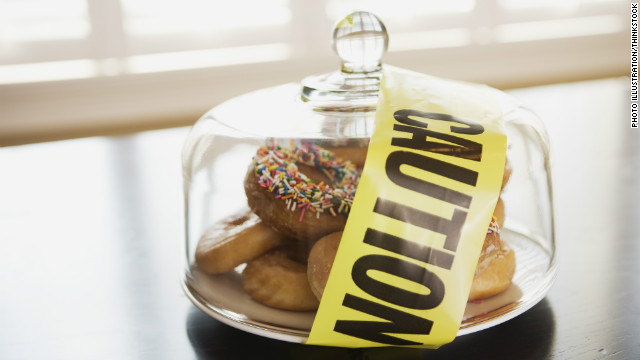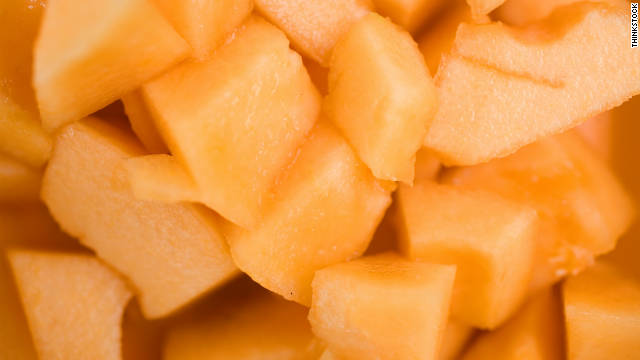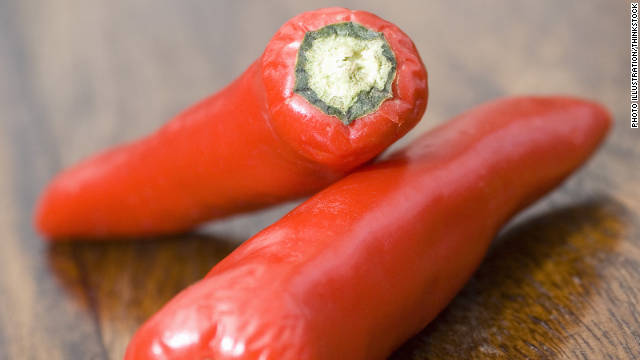- Lawsuit claims tainted meatloaf caused elderly couple's death
- Bob Evans Restaurants says suit is "entirely without merit"
- The case will be heard in federal court in West Virginia early next year
(CNN) -- The children of an elderly West Virginia couple who passed away months apart in late 2012 and early 2013 are blaming their deaths on a restaurant chain's meatloaf.
Mark and Ann Starcher say a tainted meal that their parents shared from a local Bob Evans restaurant in October 2012 made them so "violently ill" that it ultimately led to their deaths, according to a lawsuit they've filed against the Ohio-based chain.
According to the complaint, about nine hours after consuming a meal of meatloaf, mashed potatoes and gravy, broccoli and a roll, Virginia Starcher -- who went by "Ginny" -- "fell violently ill" shortly before Harold Starcher "also became violently ill but was able to call 911 for ambulance transport for both."

 The Centers for Disease Control and Prevention estimates that 48 million people suffer from foodborne illnesses each year in the United States. Stay safe by following these steps outlined by the Food and Drug Administration:
The Centers for Disease Control and Prevention estimates that 48 million people suffer from foodborne illnesses each year in the United States. Stay safe by following these steps outlined by the Food and Drug Administration:  Clean properly: Wash all produce thoroughly with water and/or a vinegar solution before eating. Make sure also to wash your hands and everything else that comes into contact with food. This includes kitchen utensils, cutting boards, countertops, tableware and cookware. Wash your hands thoroughly with warm water for at least 20 seconds before touching food, after handling uncooked meat or produce, and after eating. Make sure you also wash your hands between preparing each type of food.
Clean properly: Wash all produce thoroughly with water and/or a vinegar solution before eating. Make sure also to wash your hands and everything else that comes into contact with food. This includes kitchen utensils, cutting boards, countertops, tableware and cookware. Wash your hands thoroughly with warm water for at least 20 seconds before touching food, after handling uncooked meat or produce, and after eating. Make sure you also wash your hands between preparing each type of food.  Separate your food: Keep uncooked food from contaminating other food with dangerous bacteria. Separate raw meat, poultry, fish and produce from one another and other foods. Use separate cutting boards for meat and vegetables, or thoroughly clean the cutting board before using it to prepare a different food.
Separate your food: Keep uncooked food from contaminating other food with dangerous bacteria. Separate raw meat, poultry, fish and produce from one another and other foods. Use separate cutting boards for meat and vegetables, or thoroughly clean the cutting board before using it to prepare a different food.  Separate your utensils: Be careful not to use the same utensils to prepare different foods without first cleaning the utensils. Finally, don't use the same utensils or dishware for both uncooked and cooked food without cleaning them first.
Separate your utensils: Be careful not to use the same utensils to prepare different foods without first cleaning the utensils. Finally, don't use the same utensils or dishware for both uncooked and cooked food without cleaning them first.  Cook food properly: Keep food out of the danger zone by cooking it thoroughly. The danger zone is where germs thrive, between 40 degrees and 140 degrees Fahrenheit. Make sure you cook food to at least 140 degrees to kill harmful microorganisms.
Cook food properly: Keep food out of the danger zone by cooking it thoroughly. The danger zone is where germs thrive, between 40 degrees and 140 degrees Fahrenheit. Make sure you cook food to at least 140 degrees to kill harmful microorganisms.  Check the temperature: Check your food's internal temperature with a food thermometer, but be careful not to contaminate food with a dirty thermometer. Make sure you clean the thermometer as you check each item. A food thermometer is the only way to know if your food is cooked enough. Simply cooking meat until it turns brown may not be an accurate indication of whether your food contains harmful bacteria. If you plan to keep food warm after cooking, make sure the internal temperature doesn't drop below 140 degrees Fahrenheit.
Check the temperature: Check your food's internal temperature with a food thermometer, but be careful not to contaminate food with a dirty thermometer. Make sure you clean the thermometer as you check each item. A food thermometer is the only way to know if your food is cooked enough. Simply cooking meat until it turns brown may not be an accurate indication of whether your food contains harmful bacteria. If you plan to keep food warm after cooking, make sure the internal temperature doesn't drop below 140 degrees Fahrenheit.  Chill: Keep foods cold and chill leftovers quickly. Check your refrigerator with a refrigerator/freezer thermometer to make sure the temperature is 40 degrees Fahrenheit or below, and make sure your freezer is 0 degrees or below. If you have leftovers or perishable foods, refrigerate or freeze them within two hours (only one hour if the surrounding temperature is above 90 degrees F). If you thaw frozen food, don't leave the food out at room temperature. Thaw the food in the refrigerator. If you need to thaw food quickly, place the food under cold running water or in the microwave. Then cook the food immediately.
Chill: Keep foods cold and chill leftovers quickly. Check your refrigerator with a refrigerator/freezer thermometer to make sure the temperature is 40 degrees Fahrenheit or below, and make sure your freezer is 0 degrees or below. If you have leftovers or perishable foods, refrigerate or freeze them within two hours (only one hour if the surrounding temperature is above 90 degrees F). If you thaw frozen food, don't leave the food out at room temperature. Thaw the food in the refrigerator. If you need to thaw food quickly, place the food under cold running water or in the microwave. Then cook the food immediately.  Photos: How to keep your food safe
Photos: How to keep your food safe 
 Each year one out of every six Americans is sickened by a foodborne illness, according to the Centers for Disease Control and Prevention. Here are some of the biggest foodborne illness outbreaks since 2001. Click here for tips on how to keep your food safe.
Each year one out of every six Americans is sickened by a foodborne illness, according to the Centers for Disease Control and Prevention. Here are some of the biggest foodborne illness outbreaks since 2001. Click here for tips on how to keep your food safe.  In 2013, Foster Farms chicken infected 634 people in 29 states with a multidrug-resistant strain of Salmonella, according to the CDC. Of the 634 cases, 38% involved hospitalization.
In 2013, Foster Farms chicken infected 634 people in 29 states with a multidrug-resistant strain of Salmonella, according to the CDC. Of the 634 cases, 38% involved hospitalization.  A salad mix and fresh cilantro from Mexico ended up infecting 631 people with the parasite Cyclospora cayetanensis in summer 2013. The parasite triggers watery diarrhea, nausea, bloating and cramping.
A salad mix and fresh cilantro from Mexico ended up infecting 631 people with the parasite Cyclospora cayetanensis in summer 2013. The parasite triggers watery diarrhea, nausea, bloating and cramping.  A hepatitis A outbreak was attributed to Townsend Farms Organic Antioxidant Blend frozen berries in September 2013. A total of 162 cases were reported, and 71 people were hospitalized, according to the CDC. Severe hepatitis cases can cause liver damage. The blend's pomegranate seeds came from a company in Turkey, which was the source of contamination.
A hepatitis A outbreak was attributed to Townsend Farms Organic Antioxidant Blend frozen berries in September 2013. A total of 162 cases were reported, and 71 people were hospitalized, according to the CDC. Severe hepatitis cases can cause liver damage. The blend's pomegranate seeds came from a company in Turkey, which was the source of contamination.  Cantaloupes tainted with salmonella infected more than 260 people across 24 states in October 2012. Three people in Kentucky died and 94 were hospitalized. Investigators determined Chamberlain Farms Produce Inc. of Owensville, Indiana, was the source of this outbreak.
Cantaloupes tainted with salmonella infected more than 260 people across 24 states in October 2012. Three people in Kentucky died and 94 were hospitalized. Investigators determined Chamberlain Farms Produce Inc. of Owensville, Indiana, was the source of this outbreak.  Salmonella in a frozen raw yellowfin tuna product, known as Nakaochi Scrape, sickened 425 people and hospitalized 55 in the spring and summer of 2012. The product was used most often to make "spicy tuna" sushi, according to the CDC.
Salmonella in a frozen raw yellowfin tuna product, known as Nakaochi Scrape, sickened 425 people and hospitalized 55 in the spring and summer of 2012. The product was used most often to make "spicy tuna" sushi, according to the CDC.  Twenty-two cases were reported of a Listeria monocytogenes infection from the Frescolina Marte brand of ricotta salata cheese in 2012, but 90% of those people were hospitalized, and four people died, according to the CDC.
Twenty-two cases were reported of a Listeria monocytogenes infection from the Frescolina Marte brand of ricotta salata cheese in 2012, but 90% of those people were hospitalized, and four people died, according to the CDC.  In September 2011, listeria in cantaloupes left 30 people dead in what was the deadliest U.S. outbreak of a food borne illness since the CDC started keeping track of listeria cases in 1973, according to the agency.
In September 2011, listeria in cantaloupes left 30 people dead in what was the deadliest U.S. outbreak of a food borne illness since the CDC started keeping track of listeria cases in 1973, according to the agency.  Between February and August 2011, the Cargill Meat Solutions Corp. recalled more than 36 million pounds of ground turkey after tests revealed a strain of salmonella. The outbreak killed one person and sickened more than 130.
Between February and August 2011, the Cargill Meat Solutions Corp. recalled more than 36 million pounds of ground turkey after tests revealed a strain of salmonella. The outbreak killed one person and sickened more than 130.  In summer 2010, more than 1,900 people were reportedly sickened by salmonella found in eggs produced by Iowa's Hillandale Farms, which voluntarily recalled about a half-billion eggs nationwide.
In summer 2010, more than 1,900 people were reportedly sickened by salmonella found in eggs produced by Iowa's Hillandale Farms, which voluntarily recalled about a half-billion eggs nationwide.  Authorities shut down a processing plant in Texas in October 2010 after four deaths were tied to listeria-infected celery produced at the site. The Texas Department of State Health Services ordered SanGar Fresh Cut Produce to recall all products shipped from its San Antonio plant.
Authorities shut down a processing plant in Texas in October 2010 after four deaths were tied to listeria-infected celery produced at the site. The Texas Department of State Health Services ordered SanGar Fresh Cut Produce to recall all products shipped from its San Antonio plant.  Between April and August 2008, 1,442 people in 43 states were infected with salmonella from Mexico-grown jalapeño and serrano peppers. At least 300 people were hospitalized, and the infection may have contributed to two deaths, according to the CDC. Walmart stores in four states recalled jars of serrano peppers as a result.
Between April and August 2008, 1,442 people in 43 states were infected with salmonella from Mexico-grown jalapeño and serrano peppers. At least 300 people were hospitalized, and the infection may have contributed to two deaths, according to the CDC. Walmart stores in four states recalled jars of serrano peppers as a result.  Nine people died from salmonella-infected peanut butter between September 2008 and April 2009. The Peanut Corp. of America had sold the tainted peanut butter in bulk to King Nut, which recalled its products. More than 700 people were infected and 166 hospitalized.
Nine people died from salmonella-infected peanut butter between September 2008 and April 2009. The Peanut Corp. of America had sold the tainted peanut butter in bulk to King Nut, which recalled its products. More than 700 people were infected and 166 hospitalized.  In the summer of 2006, more than 200 people became infected with E. coli from spinach grown on a single California field. Investigators traced the prepackaged spinach back to Natural Selection Foods and baby spinach sold under the Dole brand name. Five deaths were linked to the outbreak.
In the summer of 2006, more than 200 people became infected with E. coli from spinach grown on a single California field. Investigators traced the prepackaged spinach back to Natural Selection Foods and baby spinach sold under the Dole brand name. Five deaths were linked to the outbreak.  During 2005 and 2006, four large outbreaks of salmonella infections hit 21 states in the United States. Tainted tomatoes being served in restaurants were found to be the cause. Investigators linked the produce to fields in Florida, Ohio and Virginia.
During 2005 and 2006, four large outbreaks of salmonella infections hit 21 states in the United States. Tainted tomatoes being served in restaurants were found to be the cause. Investigators linked the produce to fields in Florida, Ohio and Virginia.  Pre-sliced Roma tomatoes purchased at deli counters in Sheetz gas stations infected more than 400 people in the summer of 2004. Two other smaller outbreaks in the United States and Canada also occurred that summer and were linked back to a tomato-packing house in Florida.
Pre-sliced Roma tomatoes purchased at deli counters in Sheetz gas stations infected more than 400 people in the summer of 2004. Two other smaller outbreaks in the United States and Canada also occurred that summer and were linked back to a tomato-packing house in Florida.  Listeria-infected sliced turkey killed eight and infected 46 others in 2002. Three pregnant women had fetal deaths. Two processing plants recalled 30 million pounds of meat following the outbreak.
Listeria-infected sliced turkey killed eight and infected 46 others in 2002. Three pregnant women had fetal deaths. Two processing plants recalled 30 million pounds of meat following the outbreak.  In 2001, cantaloupe was again the culprit. Salmonella tainted the fruit that killed two, hospitalized nine and infected 50 in an outbreak that started in Mexico.
In 2001, cantaloupe was again the culprit. Salmonella tainted the fruit that killed two, hospitalized nine and infected 50 in an outbreak that started in Mexico. Worst foodborne illness outbreaks
 Photos: Worst food-borne illness outbreaks
Photos: Worst food-borne illness outbreaks Both were told by emergency room staff at Jackson General Hospital in Ripley, West Virginia, that they had suffered from food poisoning "from consuming the tainted meal from Bob Evans."
The next day, the children allege that their dad -- who went by the nickname "Punk" -- "suffered a stroke after becoming violently ill from consuming the tainted meal from Bob Evans," resulting in both parents being moved into a rehabilitation facility.
Neither would return home.
About two months later, Ginny, who served in the West Virginia Legislature in the 1980s, died in hospice care. Punk -- who was healthy, active and still operating his business at the time of the Bob Evans meal, according to the suit -- deteriorated rapidly thereafter. The next few months of his life would be spent in an intensive care unit before he, too, passed away.
Protect yourself from food poisoning
Mark and Ann Starcher want $250,000 for medical expenses from Bob Evans Restaurants, as well as an unspecified amount for the "pain, suffering, emotional distress, mental anguish and the loss of ability to enjoy life" that were caused by their parents' deaths.
A spokesman for the restaurant chain, which has 600 locations in 19 states, said that while it's the company's policy not to comment on pending litigation, "we believe this is an appropriate and important exception to the rule."
"Bob Evans is committed to serving the safest, highest-quality foods for our guests -- that is our responsibility and our priority," said Scott Taggart, who added that the company "sympathize(s) with this family for the loss of their loved ones." However, Taggart said that the company had done "a thorough review of the alleged claims in this matter, and quite simply, there is no basis to the allegations contained in the complaint and the suit is entirely without merit."
The case will be heard in federal court in West Virginia early next year.
Caramel apples linked to fatal listeria outbreak







